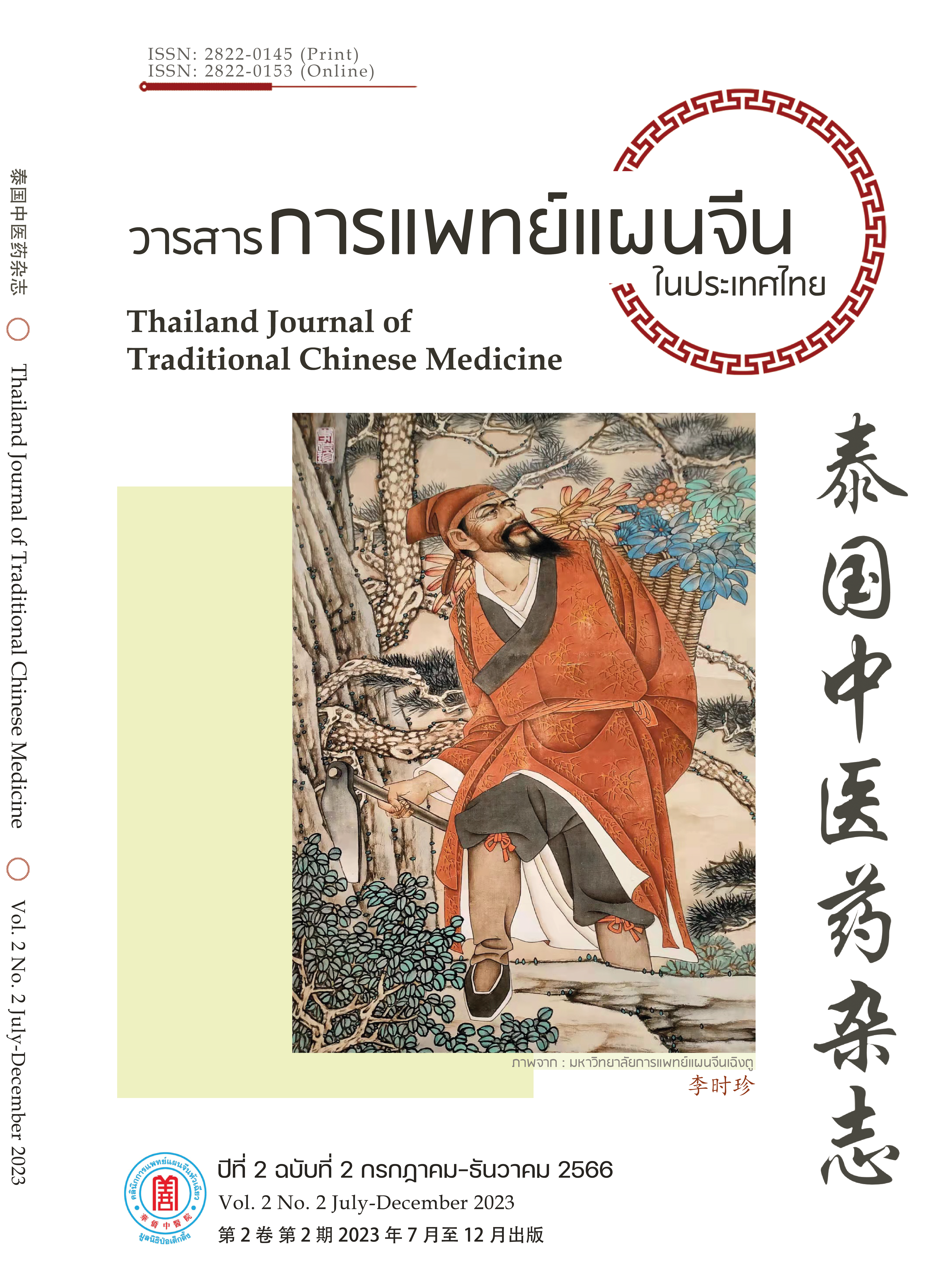ความสัมพันธ์ของทฤษฎีจิงจินและทฤษฎีกล้ามเนื้อและเยื่อพังผืดมาใช้ในการวินิจฉัยและรักษาโรคเกี่ยวกับอาการปวด
Main Article Content
บทคัดย่อ
ทฤษฎีจิงจิน เป็นแนวคิดบนพื้นฐานทฤษฎีการแพทย์แผนจีน มีการเชื่อมโยงระบบกล้ามเนื้อและเส้นเอ็นที่เชื่อมโยงกับเส้นลมปราณทั้งสิบสอง ส่วนทฤษฎีกล้ามเนื้อและเยื่อพังผืด เป็นแนวคิดของการแพทย์สมัยใหม่ ซึ่งพัฒนามาจากพื้นฐานของกายวิภาคศาสตร์ จากมุมมองและสถานะการศึกษาวิจัยของทฤษฎีกล้ามเนื้อและเยื่อพังผืดนี้ มองว่าเป็นโครงสร้างของร่างกายคนเราที่ดึงยึดส่วนต่างๆ ทั้งกระดูก กล้ามเนื้อมัดเล็ก เส้นเอ็น เนื้อเยื่อพังผืด เป็นต้น ประกอบเข้าด้วยกัน โดยแต่ละส่วนมีการเชื่อมโยงกันเป็นแบบเครือข่ายลูกโซ่ เพื่อรักษาโครงสร้างของร่างกายและความมั่นคงในการทำงาน การเคลื่อนไหวของร่างกายให้เป็นไปอย่างปกติ อาการปวดถูกจัดเป็นสัญญาณชีพที่ห้าที่สำคัญของร่างกาย ซึ่งเป็นอาการแสดงที่สำคัญของร่างกายที่บ่งบอกถึงความผิดปกติที่เกิดขึ้นในร่างกายของคนเรา และมักจะเป็นปัญหาที่สร้างความรำคาญใจที่สุดปัญหาหนึ่ง มีผู้ป่วยมากมายที่ยังเผชิญกับความปวดทั้งเฉียบพลันและเรื้อรัง และความปวดที่รักษาไม่หายไม่สามารถบรรเทาได้ ในบทความนี้จะให้แนวคิดและแนวทางในการรักษาใหม่ๆ ในการรักษาอาการปวดโดยอาศัยทฤษฎีจิงจินและทฤษฎีกล้ามเนื้อและเยื่อพังผืด
Article Details
เอกสารอ้างอิง
Luo WX, Cai BY, Li JY, He YC, Du L, Gao MJ, et al. A preliminary study on the correlation between the Jingjin theory and the myofascial theory. Journal of Traditional Chinese Medicine. 2020;61(14):1220-4. (in Chinese)
Wu M, Fan XX, Ding K, Zhang W. Application of myofascial chain theory in pain diagnosis and treatment. Chinese Manipulation and Rehabilitation Medicine. 2022;13(1):71-4. (in Chinese)
Thai Association for the Study of Pain, Thai Mopain Society. Recommendations myofascial pain syndrome fibromyalgia 2020. Bangkok: Amarin Printing & Publishing; 2020. (in Thai)
Thai Association for the Study of Pain. Clinical practice guideline for myofascial pain syndrome fibromyalgia. Bangkok: Amarin Printing & Publishing; 2009. (in Thai)
Zheng HX. Basic theory of traditional Chinese medicine. 4th ed. Beijing: China Traditional Chinese Medicine Publishing House; 2016. (in Chinese)
Shi XM. Acupuncture and moxibustion. 2nd ed. Beijing: China Traditional Chinese Medicine Publishing House; 2007. (in Chinese)
Focks C. Atlas of acupuncture. 1st English ed. Beijing: Churchill Livingstone Elsevier;2008.
Williams FW. "Rolfing". Encyclopedia of pseudoscience: from alien abductions to zone therapy. New York: Routledge; 2013. p. 303.
Thomas WM. Anatomy Trains - myofascial meridian for manual & movement Therapists. 2nd ed. London: Elsevier - Churchill Livingstone; 2009.
Yu XF, Yang B, Pan LF. Application experience of myofascial theory in clinical rehabilitation. Health for Everyone. 2019;37(4):119-20. (in Chinese)
Lu Y. Study on the efficacy of myofascial strength training on middle-aged and elderly patients with knee osteoarthritis [dissertation]. Shandong: Qufu Normal University; 2020. (in Chinese)
Wang FY, Dong BQ, Song J. Exploration on the application of myofascial theory in acupuncture treatment of KOA. Journal of Liaoning University of Traditional Chinese Medicine. 2017;19(6):119-21. (in Chinese)
Dorsher PT. Myofascial referred-pain data provide physiologic evidence of acupuncture meridians. The Journal of Pain. 2009;10(7):723-31.
He XL, Guo YR, Zhang L. The anatomical correspondence between myofascial arm lines and hand Jingjin. Modern Medical Journal. 2019;47(7):881-5. (in Chinese)
Stecco A, Gesi M, Stecco C, Stern R. Fascial components of the myofascial pain syndrome. Curr Pain Headache Rep. 2013;17(8):352.
Simon DG, Travell JG, Simon LS. Travell & Simons' myofascial pain and dysfunction: upper half of body. 2nd ed. Philadelphia: Lippincott Williams & Wilkins; 1988.
Wang ZT, Yang H, Wei QL. Application of the theory of meridians in motor system diseases. Asia-Pacific Traditional Medicine. 2020;16(8):194-7. (in Chinese)
Elisa JM, Eloisa GS, Graciele BM. Myofascial pain syndrome as a diagnosis of chronic abdominal pain: case report. Brazilian Journal of Pain. 2021;4(2):180-3.
Wang Q, Bao YX. Analysis on the principle of acupuncture analgesia. Chinese Journal of Traditional Chinese Medicine. 2019;34(10):4911-3. (in Chinese)
Xie ZQ, Wang YS. Overview of the origin, theory and clinical research of Jingjin therapy. Global Traditional Chinese Medicine. 2014;7(1):35-6. (in Chinese)
Guo Q. Clinical study on the treatment of chronic non-specific low back pain with floating acupuncture based on the Jingjin theory. Contemporary Medicine. 2021;27(28):141-2. (in Chinese)
Feng CY. Acupuncture on Sanjian and Ashi point and cupping to treat tenosynovitis of the long head tendon of the biceps brachii. Journal of New Chinese Medicine. 2011;43(5):119-20. (in Chinese)
Fan CL. Clinical observation on 56 cases of tenosynovitis of the long head of biceps brachii treated with acupuncture at Yuji combined with local warm acupuncture. Jiangsu Journal of Traditional Chinese Medicine. 2012;44(7):62-3. (in Chinese)
Chen NL, Yao HH. Analysis on the treatment of cervical spondylosis with TCM Tuina based on the Jingjin theory. China's Naturopathy. 2023;31(14):19-21. (in Chinese)
Ren YJ, Gu CQ, Yang YQ, Yang P, Ma HW. Effects of Tuina under the guidance of Jingjin theory on lumbar function and pain in patients with lumbar disc herniation. Modern Medicine and Health Research. 2023;7(3):83-6. (in Chinese)
Ma JH, Wang JX. Clinical Effect of diosmin combined with channel sinew tuina on breast cancer-related lymphedema. Smart Healthcare. 2022;8(35):100-21. (in Chinese)
Deng SN, Bin LL, Wang T, Zhou BL, Hu LX. A study of scraping treating cervical disease by the tendon lesion. Chinese Journal of Ethnomedicine and Ethnopharmacy. 2009;18(6):34-6. (in Chinese)
Ai CY, Wu N, Li YN, Tian L, Wang Z, Meng FZ. Exploration on theory of treating by head meridian scraping with intradermal acupuncture and an analysis of case. Clinical Journal of Chinese Medicine. 2020;12(34):54-6. (in Chinese)
Liu QG, Huang QM, Liu L, Nguyen TT. Efficacy of dry needling under EMG guidance for myofascial neck and shoulder pain: a randomized clinical trial. J Pain Res. 2022;23(15):2293-302.
Lin X, Li F, Lu H, Zhu M, Peng TZ. Acupuncturing of myofascial pain trigger points for the treatment of knee osteoarthritis: a systematic review and meta-analysis. Medicine. 2022;101(8):1-7.
Li LL, Jiang X, Wan YX, Qi XW, Huang JC. Exploration of the thinking and methods in treatment of cancer pain with acupuncture and moxibustion on the base of the fascia theory. Chinese Acupuncture & Moxibustion. 2023;43(8):894-8. (in Chinese)
Lertsinthai P. Extracorporeal shock wave therapy in musculoskeletal disorders. J Med Tech Phys Ther. 2015;27(2):107-24. (in Thai)
Zhang WB, Shang HS, Han FM, Jin HB, Liu LM, Yuan XY. Comparative analysis of painful heel syndrome treated by extracorporeal shock wave under guidance of "Myofascial Chain" theory and simple pain-point. Chinese Manipulation and Rehabilitation Medicine. 2020;11(18):48-54. (in Chinese)
Rattawongsa J, Yikhian C, Chunphongthong P, Khonchalad K. Comparing the effects of ultrasound therapy with Swedish massage in patients with trapezius myofascial pain. Thai J Phys Ther. 2012;34(2):112-3. (in Thai)
Xiao QM, Wu XJ, Yin H, Qiu F, Li Z, Zhang X. Clinical effect of manipulation therapy for the treatment of degenerative lumbar instability based on myofascial chain theory. China J Orthop Trauma. 2020;33(10):928-32. (in Chinese)
Wang W. Research on the application of dance training and myofascial relaxation. Journal of Ezhou University. 2015;22(4):62-3. (in Chinese)


